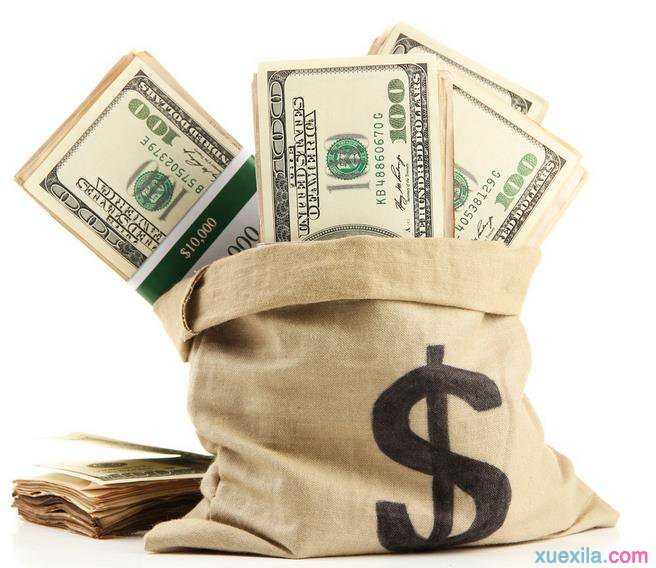美元的起源
世界货币千奇百样,然而它们的起源都是什么呢?都是以什么命名的呢?随小编一起踏上这奇妙的货币探寻之旅吧~首先来看看美元
至高无上的美元起源于现今的捷克共和国。1519年,位于Joachimstal镇 (意为 Joachim山谷,源于德语“Tal”为“山谷”)附近的一座银矿开始制造银币,银币的名称,不假思索的取名为Joachimster,这种银币广泛流通,后来名称简化为“taler”,变的更加有名。在荷兰及德国南方,taler一词开头的辅音常常软化而变成 “daler”。英语采用了这一形式,最终其拼写为现在的 “dollar”一词的形式。
在美国殖民地,以前没有标准的货币。最广泛使用的是西班牙比索,也称之为 “八片币”,因为它可以分成包子状的八块。英国殖民主义者把这种钱币非正式的称为dollar(元)。1785年,美洲殖民地大会确定了美国货币,他们根据毛里求斯总督和托马斯.杰弗逊的建议把dollar(美元) 作为标准货币单位名称。因为dollar 一词已广为人知,它与任何形式的英国官方货币无关。(杰弗逊还命名了硬币角(disme), 起源于法语dixieme, 作为一美元的十分之一,发音为“deem”, 最终演变为dime)
美元的符号$的起源与好几种民间传说有关。一种说法是:它是由托马斯? 杰弗逊发明的,为TS交织字母的标记。杰弗逊首次将这符号与美元联系起来,但这种说法未免有点荒诞。另一种说法是:原来是字母U加在字母S上,当然代表 U.S.(美国)。后来由于印刷技术差的缘故,U的底部未印出来,结果就剩下两条竖杠在字母S上。还有一种说法是,它是数字“8”的变体,“8”曾经出现在西班牙比索上,代表“八片币”。这最后一种说法与事实相近,但也不能令人信服。

西班牙皇室将$这一符号用在饰有纹章的盾牌上,两个柱子(代表大力神在直布罗陀和摩洛哥的两根柱子)与一面招展的旗帜相交,有“超级”的含义。这一符号出现在比索上,很像今天$这一符号。在美洲殖民地,它被用来作为比索的符号,后来转用来代表美元。
美国是第一个将官方货币命名为“元”的国家。1797年,英国银行开始铸造面值为“元”的硬币,作为银行发行的货币。其他国家相继采用“元”作为他们的货币,他们不是模仿美国就是模仿寿命不长的英国银行的做法。
其他的货币起源:
A fistful of dollars
第一把美金
The dollar is one of the most common currencies in the world used by the US, Australia, Canada, Fiji, New Zealand, and Singapore to name a few. The origin of the dollar, also the Slovenian tolar, is from a coin called the Joachimsthaler, shortened to Thaler, named after the valley in which the silver it was made from was mined, the Joachimsthal, literally ‘Joachim’s valley’. The term began to be used in other languages, especially Dutch, and was later applied to the most widely used coin in the American colonies. In 1792, it was adopted as the name of the US monetary unit.
美元是世界上最通用的货币之一,美国、澳大利亚、加拿大、斐济、新西兰和新加坡都有使用。美元及斯洛文尼亚托拉尔,都起源于约阿希姆斯塔尔币,简称塔尔币,以盛产银矿的村庄约阿希姆命名。该词最初是在其他语言中被使用的,尤其是荷兰语,后来在美国殖民地被用作称呼钱币。1792年,被采纳为美国钱币官方命名之一。
All that glitters is not gold
闪光的不都是金子
Many countries use the dinar, which comes from the Latin denarius, an ancient Roman silver coin: Jordanian dinar, Algerian dinar, Serbian dinar, and Kuwaiti dinar among others. The Indian and Pakistani rupee derives from the Sanskrit rupya meaning ‘wroughtsilver’.
约旦、 阿尔及利亚、塞尔维亚、科威特等等,这些国家的都以第纳尔为货币单位,源于拉丁语中的古罗马银币。印度和巴基斯坦卢比源于梵文的卢比,意为锻造银币。
The South African rand is named after the Witwatersrand, the area around Johannesburg known for its gold deposits. The Hungarian forint comes from the Italian fiorino, originally the name of a gold coin from Florence, Italy with a flower (Italianfiore) stamped on it. The British coin the florin (used until 1971) has the same origin.
南非的兰特以威特沃特斯兰德命名,该地以金储量闻名;匈牙利福林和英国弗洛林(1971年停用)源于意大利菲奥里诺,起初是佛罗伦萨印花金币的名字。
Serrated edges on coins became popular when coins were made of precious metals like gold and silver because the ridges made it harder for people to scrape off metal and devalue the coins.
当钱币开始用金银等稀有金属制造时,锯齿形边开始流行,这样更不容易刮去金属使钱币贬值。
Doing the rounds
钱币看一"圈"
Chinese yuan 元, Japanese yen 円, and Korean won 원, all originate from the Chinese character 圓 meaning ‘round’ or ‘round coin’. Although in English, we speak about the Hong Kong dollar or the New Taiwan dollar, in Chinese these are referred to as yuán 圓.
中国的元,日本的円,韩国的원都起源于汉字圓,意为“圆形的”或者“圆形钱币”。尽管在英语中,我们将香港和台湾货币称为dollar,在汉语中它们都叫“元”。
Royal crown
皇室王冠
Many Scandinavian countries use currency whose name is ultimately derived from the Latin corona meaning ‘crown’: Swedish krona, Norwegian krone, Danish krone, Icelandic króna as well as the Estonian kroon (now replaced by the Euro) and the Czech koruna. The Spanish real, a former currency of Spain derived from the Latin regalis meaning ‘royal’ which is the origin of a number of Middle Eastern currencies.
很多斯堪的纳维亚国家(如瑞典、挪威、丹麦、冰岛、爱沙尼亚、捷克等)的名称最初都起源于拉丁语科罗娜,意为王冠。西班牙前货币雷亚尔则起源于拉丁语皇室一词,中东许多国家的货币也起源于此。
A weighty subject
重量单位
Although the Germans and the Finns use the Euro now, their former currencies the German mark and the Finnish markka, both have their origin in units of weight. While the Spanish peso meaning ‘weight’ in Spanish, is also no longer used in Spain. The Russian ruble or рубль, was originally a measure of weight used for silver. The Italian and Turkish lira also have their origins in units of weight from the Latin libra meaning ‘pound’.
尽管德国和芬兰现在使用欧元,它们原先的货币马克源于重量单位;西班牙比索的意思是重量,但目前在西班牙已不再流通;俄罗斯卢布起先是称量银子的重量单位;意大利和土耳其里拉同样源于拉丁语意为“磅”的词汇。
美元的起源相关文章:
1.现代速读的起源和发展
2.篮球运动的起源英语介绍
3.为什么韩国叫棒子

美元的起源的评论条评论